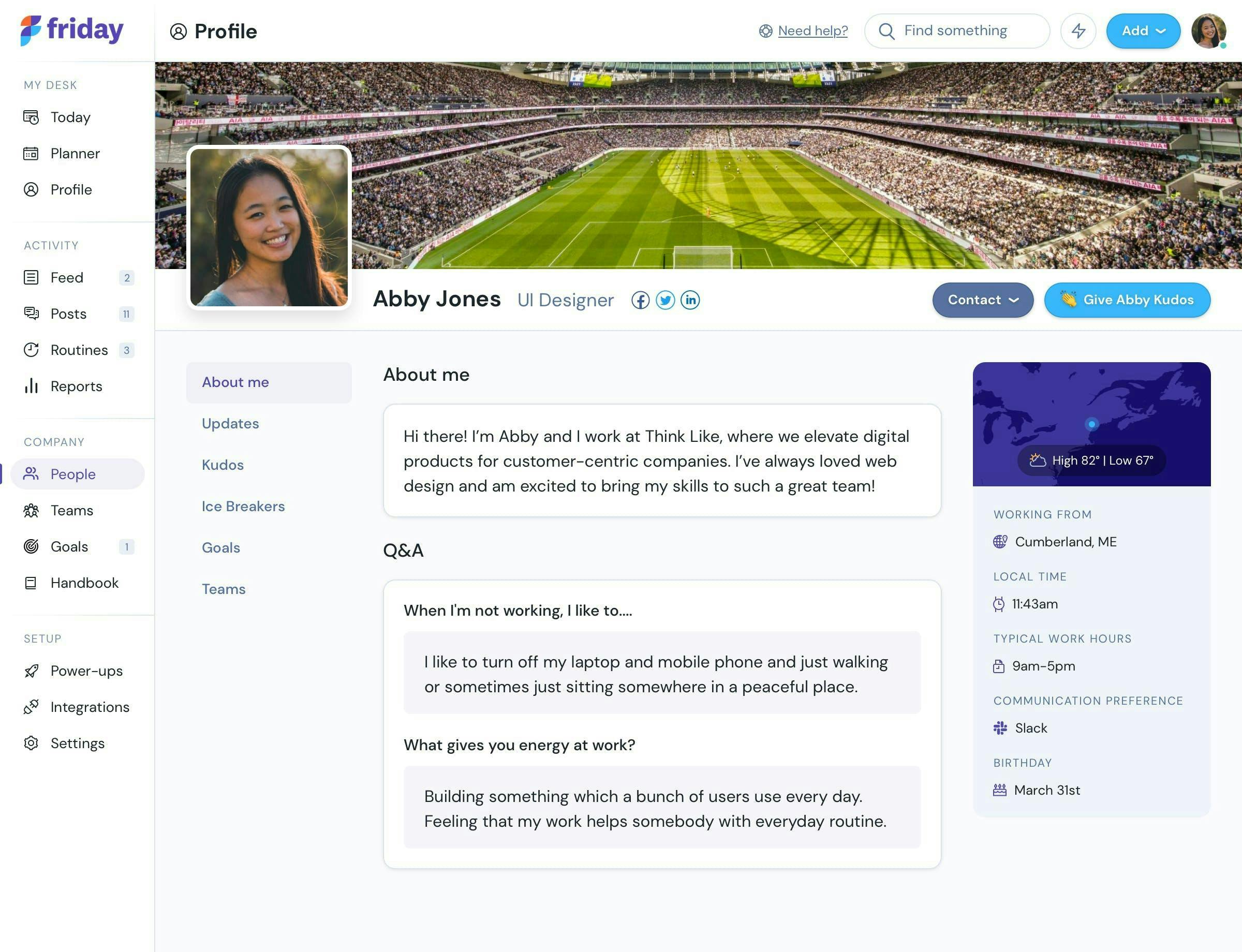What Makes a Good Intranet Content Strategy? (& How to Effectively Create One)

Intranet content management is concerned with creating and monitoring the news, announcements, and comments on a company’s intranet.
It ensures secure communication between employees and provides a framework for storing organizational information for collaboration.
This post explains what makes a good intranet strategy and gives you the tools to create one effectively.
Let’s get started!
What content is useful for the company intranet?
Intranet content is specific to the organization and its members.
This includes employee data, boilerplates,product/service material, HR documentation, Intranet manuals and guides, company news, and search metadata.
Here is a breakdown of useful intranet content:
1. Company announcements, news & updates
Posting company announcements and news is an effective way to keep your members informed about the company’s progress. It also helps them respond more accurately to customer queries about public announcements and news.
Sharing status updates, especially when the company is going through a change, helps members keep track of what the company is doing.
Managers can use the intranet to give general feedback like recognizing hardworking employees or sharing benevolent information about an employee (such as hospitalization or demise).
2. Employee handbook and company policies
Sharing resources such as company policies, employee handbook, and work standards on the intranet make them accessible to everyone. This is particularly important when onboarding new employees into the organization.
3. Detailed employee profiles

Sharing employee profiles helps colleagues know more about each other. Detailed profiles allow employees to know whom to refer to or communicate with on certain issues.
For instance, they would know the IT experts to call when they have a technical issue with their systems.
4. Forums and internal communication
Forums are still relevant for the intranet. They create a space where employees can ask questions, share insights, discuss, bond, and get timely support from the help desk.
A Q&A space would allow members and experts to interact and solve their problems.
Managers and executives could use the forums to understand the issues affecting their employees (work-related or social) and respond effectively.
At Friday, posts are used for company or team announcements, brainstorming, meeting notes, and more. It’s your internal forum to share context beyond the noisiness of Slack.
5. Templates and boilerplates
Boilerplate documents and templates capture the voice and brand of your organization. They standardize commonly used documents.
Common boilerplate documents include:
- General contracts
- Non-disclosure agreements
- Blog posts and articles
- Leave applications
- Employee handbook & policies
6. Product/Service Documentation
Relevant documentation would include information about the company’s products and services, marketing campaigns, service charters, project documentation, and tutorials.
Any material concerning the company’s products or services that is stored in filing cabinets needs to be on the intranet. This would help employees access vital information instantly from their office or home.
7. Tutorials and guides
Have information that shows employees how to use the organization’s information systems.
Tutorials and guides are useful for onboarding new employees and retraining.
They may take time to prepare, but they are a worthy addition to your intranet content.
8. Search for documents and files
Since the intranet user is the employee, it’s important to anticipate their needs, like finding information quickly and accurately.
One way to organize your content is with metadata, tags, and file descriptions. In addition, company wiki tools like DokuWiki will help them find information that they need.
Make the intranet search engine more robust by using common keywords and search terms.
Note: Unified search is coming soon to Friday!
What makes for good intranet content?
- Relevant
- Easy to find
- Concise
- Up-to-date
When intranet content is relevant, employees can rely on it to make informed choices that influence their work performance.
Good intranet content is easy to find using a robust search engine, visible search bars, clear categories, and metadata.
Concise and current intranet content means employees can get the information quickly and apply it to their work.
A good intranet content strategy makes it easy for members to find and use current, relevant, easy-to-find, and applicable information.
How do you organize content on the intranet?
How you organize content will determine the buy-in and frequency of intranet use by employees. So it makes sense to address the technical and visual intranet components beforehand.
Here are our best practices for organizing intranet content:
- Use tags: For every piece of content, add relevant keywords. This will help intranet users find the information quickly.
In Friday, you can also attach company values to your posts. - Publish regularly: This will guide you on the frequency and publishing dates of different content types. Some teams may want to use a regular cadence (like monthly product updates).
- Create categories for types of announcements: Design templates that help contributors create and publish content quickly and effectively.
Your post template could have the following guidelines:
- Short paragraphs of 1-3 sentences.
- Simple language that can score 5 or below on the Hemmingway editor. No jargon unless necessary.
- Catchy titles that motivate the employee to check the content
- Answer targets below the title and major subheadings
- Numbering and bulleting to create lists.
- Multimedia such as infographics and images make the content more visually stimulating and engaging.
- A call-to-action (CTA) requires an action from the intranet user, such as commenting or enrolling in a training program.
- Helpful links that direct employees to relevant information.
How do you create an effective intranet?
An effective intranet strategy requires that you define content, verify contributors, produce engaging information, publish the content, and manage the intranet structure.
Below are detailed steps for creating an effective intranet:
1. Identify contributors
You can have different contributor scales depending on their status in the organization. For instance, the contributor level for a C-level executive would be different from a department head.
Here are different ways you can identify and assign contributors:
- Internal Comms: Set up strategies for internal company news, policies and product announcements
- HR - Human resources content such as recruitment, training, and internal affairs.
- Marketing manager - Company news and updates
- C-level executive - mission and vision-related content
- Department heads - product or service documentation, tutorials, and updates
- Employees - create new forum posts and lead discussions
- Moderators - monitor and control intranet usage and communication between stakeholders
- Intranet administrator - create new databases and monitor information storage and retrieval.
You can take on the intranet content manager role. This involves supervisory and governance duties.
Part of this governance would be to centralize workflow from contributors, editors, and admins.
Ensure that you assign content creation as a responsibility, allocate enough time for the process and recognize the creators who do an excellent job.
Having the author name and their contact info on every post they write will keep the creators accountable.
You can also allow the readers to make content as inappropriate in addition to having a way for the reader to contact the author.
2. Create the content
Writing content for the intranet takes time and practice.
One way to ensure the content is accurate, relevant, timely, concise, and accessible is to create content guidelines.
The intranet guidelines would outline the expectations from contributors and help them produce visually-stimulating content that’s easy to scan and understand.
Tips to make content engaging for intranet users:
- Add a CTA on each post and webpage
- Provide opportunities for dialogue such as a comment section or feedback mechanism
- End your post with a question. This will encourage the user to share their opinion.
3. Publish the content
Before you post content to the intranet, confirm that it adheres to the company’s communication guidelines and policies.
A content template would help content creators confirm that their deliverables satisfy publishing guidelines. It simplifies their writing process and makes sure that they create the right content.
This could be stored in Friday, Google Drive, or another tool like Notion.
The content template could include elements like:
- Appealing headline
- Keywords
- Metadata
- Date format
- Internal linking
- Tagging content
- Comment section
- CTA
4. Manage the intranet
Managing intranet content involves defining an internet content structure and outlining compliance rules.
Specifically, the compliance structure would include:
- Roles and responsibilities of content contributors, intranet moderators, and intranet administrators
- Intranet content policy
- Intranet structure
- Publishing and approval processes
- Intranet software documentation
- Information backup and archiving
Having a structure prevents the company from having outdated intranet content. It gives you a mechanism for controlling the content, when, and how to publish.
Governing the intranet is a trial and error process. You may not get the balance right the first time. Too much governance would increase your control and make employees less likely to use the intranet. Too little governance means little control over the content.
A governance structure forms the pillars for the intranet content. Without it, your ability to produce timely, relevant, and useful content will be hampered.
How do companies use intranets?
Companies use intranets to share organizational information. This is mostly unidirectional communication from the company to the employees, like manuals, guides, blog posts, and tutorials.
Some companies use intranets to solicit information from employees. They use open feedback mechanisms and forums to hear from employees.
Managers can use this information to understand what drives their teams, what affects their work performance, and aspects of the organizational culture affecting employee morale.
The most effective way to use intranets is to use bi-directional communication between the leadership and employees.
This ensures that all stakeholders feel heard and makes them more likely to use the intranet to learn from each other.
Who should post on the company intranet?
An approved list of contributors with publishing responsibilities should post on the company intranet.
The intranet governance structure would outline the contributor’s roles and rights to post information.
You could have a team of editors who verify the content before it’s posted. The editor would check the source, hyperlinks, and presentation format is correct.
The governance structure could also assign admin rights to a select few who publish intranet content.
The admins could work under a content manager who approves and monitors content on the intranet.
How do you drive employees to the intranet?
Content is one of the most important factors that can drive an employee to the intranet. Employees will feel drawn to the intranet when the content is relevant, up-to-date, concise, and engaging.
But even with good content, distribution is key. How do you ensure that the information reaches the people it’s intended for?
According to Luke Thomas, CEO of Friday, leaders need to consider the following when sharing top-down updates:
- Distribution channels: What channels will ensure that as many people as possible get the information?
- Feedback loops: How can you understand what people think about the message?
- Adaptation: What are the implications if people don’t receive or respond to your important update, and what can you do about it?
You can drive an employee to the intranet by:
- Curating the right type of content. Mix your written content with audio and visual components such as videos, podcasts, and infographics.
- Using catchy headlines. Just like external blogging works with engaging headlines, so does internal blogging. Include the main keyword in your title to help with indexing.
- Including summaries at the beginning of the post.
- Sharing concise information. Start with the most relevant information on the onset. Avoid hiding important details in pages of text.
- Using contemporary visuals to make the content more stimulating.
- Formatting for visual appeal. Use short paragraphs of 1-3 sentences, add lots of white space, incorporate graphics, and make headings stand out. Break lists into numbers and bullets to make the content readable.
- Using proper naming structure for files. Descriptive file names help the reader know what they contain and eliminate confusion.
Beyond sharing static content such as policies and templates, you could consider crafting material that appeals to the employees’ pain points and needs. This would draw them in because they would feel heard and valued.
Another way to encourage intranet use is to allow employees to volunteer as contributors. Also, giving them the freedom to create forum threads and posts promotes autonomy.
A successful intranet satisfies the information needs of the company’s leadership and the employees. It is important that both feel that the intranet content addresses their pain points.
Your intranet becomes effective when you create and publish relevant, timely, useful, and well-indexed content.
Friday as Your Company Home & Modern Intranet
If the traditional intranet is just static pages with forgotten logins, the modern intranet is the centralized hub that glues your work together.
The modern intranet:
- Makes it simple to post company announcements & updates
- Provides team check-ins
- Aligns employees to bigger goals
- Creates connections
- Creates context at scale (not dependent on office drop-ins)
- Helps each individual employee plan their day
- Integrates with all systems of record, like HRIS, Project management, and work chat
- Takes minutes instead of months to build with easy-to-use widgets
Friday is the glue of the digital workplace, re-imagining internal communications for employees with an updated experience.
Pricing:
- Individual Pro: $4 per month. Perfect for individuals who want to see how Friday works
- Teams: $6/per person /month. An offering for teams who want to use Friday as a small group
- Company/Enterprise: For entire organizations who want to create a customizable company home.
Use Friday for free. No credit card required. Try all the features for the first 2 weeks.
Intranet Content FAQ
Have your questions about modern intranet content and design answered.



